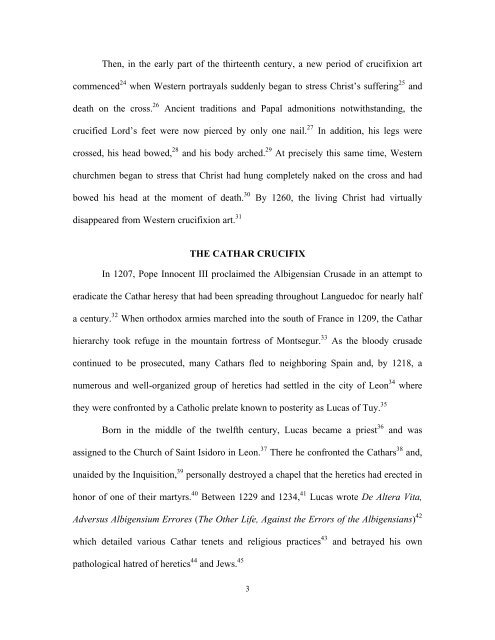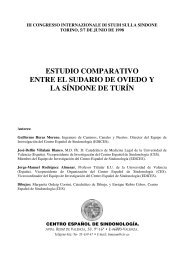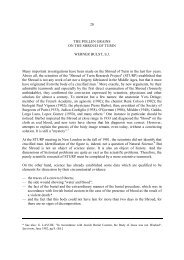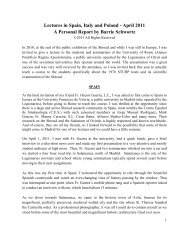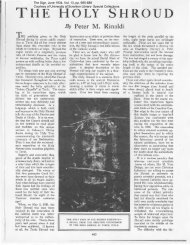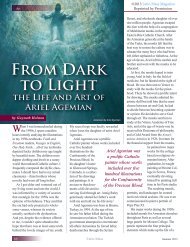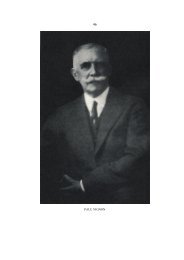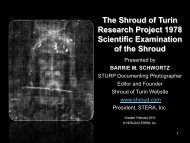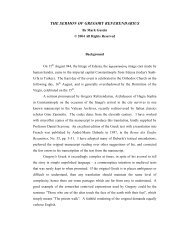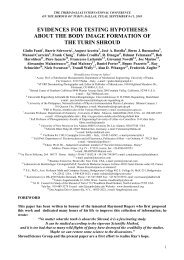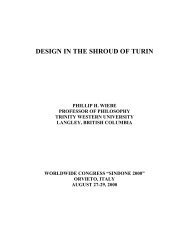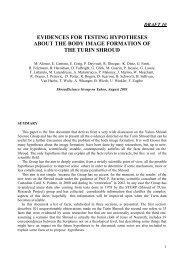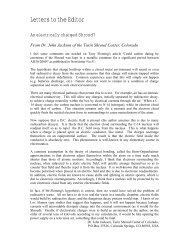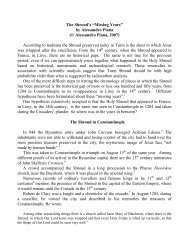the cathar crucifix - The Shroud of Turin
the cathar crucifix - The Shroud of Turin
the cathar crucifix - The Shroud of Turin
Create successful ePaper yourself
Turn your PDF publications into a flip-book with our unique Google optimized e-Paper software.
<strong>The</strong>n, in <strong>the</strong> early part <strong>of</strong> <strong>the</strong> thirteenth century, a new period <strong>of</strong> <strong>crucifix</strong>ion art<br />
commenced 24 when Western portrayals suddenly began to stress Christ’s suffering 25 and<br />
death on <strong>the</strong> cross. 26 Ancient traditions and Papal admonitions notwithstanding, <strong>the</strong><br />
crucified Lord’s feet were now pierced by only one nail. 27 In addition, his legs were<br />
crossed, his head bowed, 28 and his body arched. 29 At precisely this same time, Western<br />
churchmen began to stress that Christ had hung completely naked on <strong>the</strong> cross and had<br />
bowed his head at <strong>the</strong> moment <strong>of</strong> death. 30 By 1260, <strong>the</strong> living Christ had virtually<br />
disappeared from Western <strong>crucifix</strong>ion art. 31<br />
THE CATHAR CRUCIFIX<br />
In 1207, Pope Innocent III proclaimed <strong>the</strong> Albigensian Crusade in an attempt to<br />
eradicate <strong>the</strong> Cathar heresy that had been spreading throughout Languedoc for nearly half<br />
a century. 32 When orthodox armies marched into <strong>the</strong> south <strong>of</strong> France in 1209, <strong>the</strong> Cathar<br />
hierarchy took refuge in <strong>the</strong> mountain fortress <strong>of</strong> Montsegur. 33 As <strong>the</strong> bloody crusade<br />
continued to be prosecuted, many Cathars fled to neighboring Spain and, by 1218, a<br />
numerous and well-organized group <strong>of</strong> heretics had settled in <strong>the</strong> city <strong>of</strong> Leon 34 where<br />
<strong>the</strong>y were confronted by a Catholic prelate known to posterity as Lucas <strong>of</strong> Tuy. 35<br />
Born in <strong>the</strong> middle <strong>of</strong> <strong>the</strong> twelfth century, Lucas became a priest 36 and was<br />
assigned to <strong>the</strong> Church <strong>of</strong> Saint Isidoro in Leon. 37 <strong>The</strong>re he confronted <strong>the</strong> Cathars 38 and,<br />
unaided by <strong>the</strong> Inquisition, 39 personally destroyed a chapel that <strong>the</strong> heretics had erected in<br />
honor <strong>of</strong> one <strong>of</strong> <strong>the</strong>ir martyrs. 40 Between 1229 and 1234, 41 Lucas wrote De Altera Vita,<br />
Adversus Albigensium Errores (<strong>The</strong> O<strong>the</strong>r Life, Against <strong>the</strong> Errors <strong>of</strong> <strong>the</strong> Albigensians) 42<br />
which detailed various Cathar tenets and religious practices 43 and betrayed his own<br />
pathological hatred <strong>of</strong> heretics 44 and Jews. 45<br />
3


